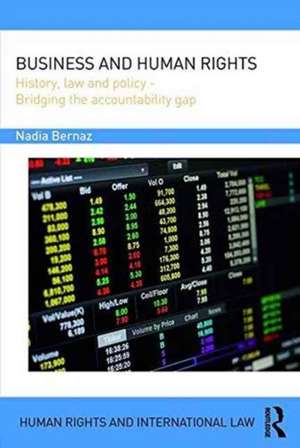Business and Human Rights: History, Law and Policy - Bridging the Accountability Gap: Human Rights and International Law
Autor Nadia Bernazen Limba Engleză Paperback – 19 oct 2016
Adopting a legal perspective, this book presents the ways in which this dual undertaking has been and could be further carried out in the future, and evaluates the extent to which the various initiatives in the field bridge the corporate accountability gap. It looks at the historical background of the field of business and human rights, and examines salient periods, events and cases. The book then goes on to explore the relevance of international human rights law and international criminal law for global business. International soft law and policy initiatives which have blossomed in recent years are evaluated along with private modes of regulation. The book also examines how domestic law, especially the domestic law of multinational companies’ home countries, can be used to prevent and redress corporate related human rights violations.
| Toate formatele și edițiile | Preț | Express |
|---|---|---|
| Paperback (1) | 387.02 lei 43-57 zile | |
| Taylor & Francis – 19 oct 2016 | 387.02 lei 43-57 zile | |
| Hardback (1) | 1168.37 lei 43-57 zile | |
| Taylor & Francis – 19 oct 2016 | 1168.37 lei 43-57 zile |
Din seria Human Rights and International Law
-
 Preț: 311.41 lei
Preț: 311.41 lei -
 Preț: 330.15 lei
Preț: 330.15 lei -
 Preț: 311.41 lei
Preț: 311.41 lei -
 Preț: 389.38 lei
Preț: 389.38 lei - 12%
 Preț: 301.55 lei
Preț: 301.55 lei - 12%
 Preț: 302.38 lei
Preț: 302.38 lei -
 Preț: 389.66 lei
Preț: 389.66 lei -
 Preț: 416.22 lei
Preț: 416.22 lei -
 Preț: 389.38 lei
Preț: 389.38 lei -
 Preț: 387.49 lei
Preț: 387.49 lei -
 Preț: 392.54 lei
Preț: 392.54 lei - 17%
 Preț: 272.02 lei
Preț: 272.02 lei - 17%
 Preț: 259.98 lei
Preț: 259.98 lei -
 Preț: 388.13 lei
Preț: 388.13 lei - 18%
 Preț: 1003.99 lei
Preț: 1003.99 lei - 18%
 Preț: 1010.53 lei
Preț: 1010.53 lei - 9%
 Preț: 1006.39 lei
Preț: 1006.39 lei
Preț: 387.02 lei
Nou
Puncte Express: 581
Preț estimativ în valută:
74.06€ • 77.52$ • 61.64£
74.06€ • 77.52$ • 61.64£
Carte tipărită la comandă
Livrare economică 31 martie-14 aprilie
Preluare comenzi: 021 569.72.76
Specificații
ISBN-13: 9781138683006
ISBN-10: 1138683000
Pagini: 326
Dimensiuni: 156 x 234 x 26 mm
Greutate: 0.48 kg
Ediția:1
Editura: Taylor & Francis
Colecția Routledge
Seria Human Rights and International Law
Locul publicării:Oxford, United Kingdom
ISBN-10: 1138683000
Pagini: 326
Dimensiuni: 156 x 234 x 26 mm
Greutate: 0.48 kg
Ediția:1
Editura: Taylor & Francis
Colecția Routledge
Seria Human Rights and International Law
Locul publicării:Oxford, United Kingdom
Public țintă
Postgraduate and UndergraduateCuprins
1. Introduction Part 1: Historical Highlights: Limited Corporate Accountability 2. The Atlantic Slave Trade: a "Business and Human Rights" Reading 3. International Labour Law: Early Development and Contemporary Significance for the Field of Business and Human Rights 4. Doing Business with the Nazis: the Criminal Prosecution of German Industrialists after the Second World War Part 2: International Law and Policy: Limitations and Progress 5. Business, International Human Rights Law and International Criminal Law: Shifting Boundaries 6. Human Rights and International Economic Law: Connecting the Dots 7. Expanding International Regulation in Business and Human Rights 8. Private Regulation in Business and Human Rights Part 3: Domestic Law and Policy: Embedding Human Rights in Business Practice 9. Shaping Law and Public Policies10. Business and Human Rights Litigation before Domestic Courts: Remaining Obstacles 11. Conclusion: The Future of Business and Human Rights
Descriere
Business corporations can and do violate human rights all over the world, and they are often not held to account. Business and human rights as a field seeks to enhance the accountability of business – companies and businesspeople – in the human rights area, or, to phrase it differently, to bridge the accountability gap. Bridging the accountability gap is to be understood as both setting standards and holding corporations and businesspeople to account if violations occur. Adopting a legal perspective, this book presents the ways in which this dual undertaking has been and could be further carried out in the future, and evaluates the extent to which the various initiatives in the field bridge the corporate accountability gap.
















